- GCN/BACODINE POSITION NOTICE
TITLE: GCN/SWIFT NOTICE
NOTICE_DATE: Mon 13 Mar 06 00:12:18 UT
NOTICE_TYPE: Swift-BAT GRB Position
TRIGGER_NUM: 201487, Seg_Num: 0
GRB_RA: 66.609d {+04h 26m 26s} (J2000),
66.683d {+04h 26m 44s} (current),
66.018d {+04h 24m 04s} (1950)
GRB_DEC: -10.872d {-10d 52' 19"} (J2000),
-10.859d {-10d 51' 30"} (current),
-10.984d {-10d 59' 02"} (1950)
GRB_ERROR: 3.00 [arcmin radius, statistical only]
GRB_INTEN: 1899 [cnts] Image_Peak=128 [image_cnts]
TRIGGER_DUR: 0.064 [sec]
TRIGGER_INDEX: 10427 E_range: 50-350 keV
BKG_INTEN: 22221 [cnts]
BKG_TIME: 710.93 SOD {00:11:50.93} UT
BKG_DUR: 8 [sec]
GRB_DATE: 13807 TJD; 72 DOY; 06/03/13
GRB_TIME: 726.29 SOD {00:12:06.29} UT
GRB_PHI: 151.19 [deg]
GRB_THETA: 31.45 [deg]
SOLN_STATUS: 0x3
RATE_SIGNIF: 129.36 [sigma]
IMAGE_SIGNIF: 8.57 [sigma]
MERIT_PARAMS: +1 +0 +0 -2 +3 +32 +0 +0 -28 +1
SUN_POSTN: 352.91d {+23h 31m 38s} -3.06d {-03d 03' 47"}
SUN_DIST: 73.50 [deg] Sun_angle= -4.9 [hr] (East of Sun)
MOON_POSTN: 153.94d {+10h 15m 46s} +13.92d {+13d 55' 17"}
MOON_DIST: 89.98 [deg]
MOON_ILLUM: 97 [%]
GAL_COORDS: 205.95,-37.07 [deg] galactic lon,lat of the burst (or transient)
ECL_COORDS: 62.59,-32.11 [deg] ecliptic lon,lat of the burst (or transient)
COMMENTS: SWIFT-BAT GRB Coordinates.
COMMENTS: This is a rate trigger.
COMMENTS: A point_source was found.
COMMENTS: This does not match any source in the on-board catalog.
COMMENTS: This does not match any source in the ground catalog.
COMMENTS: This is a GRB.
COMMENTS: This trigger occurred at longitude,latitude = 284.42,-3.39 [deg].
- red DSS finding chart
ps-file
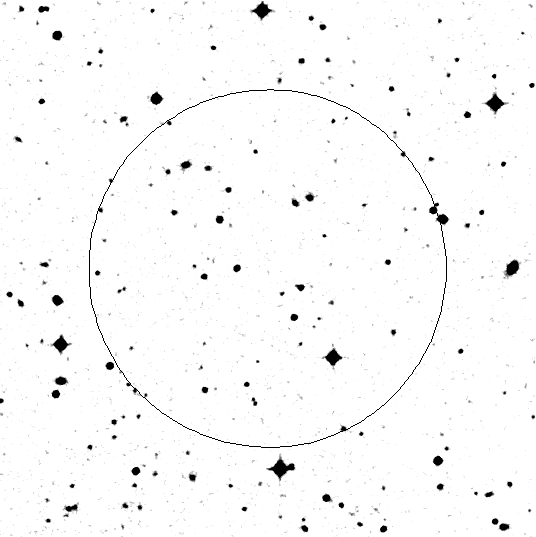
- GCN NOTICE
TITLE: GCN/SWIFT NOTICE
NOTICE_DATE: Mon 13 Mar 06 00:13:34 UT
NOTICE_TYPE: Swift-XRT Nack-Position
TRIGGER_NUM: 201487, Seg_Num: 0
POINT_RA: 66.599d {+04h 26m 24s} (J2000)
POINT_DEC: -10.865d {-10d 51' 54"} (J2000)
IMG_START_DATE: 13807 TJD; 72 DOY; 06/03/13
IMG_START_TIME: 804.98 SOD {00:13:24.98} UT, 78.7 [sec] since BAT Trigger Time
COUNTS: 68 Min_needed= 20
STD_DEV: 0.00 Max_StdDev_for_Good=28.44 [arcsec]
PH2_ITER: 4 Max_iter_allowed= 4
ERROR_CODE: 2
COMMENTS: SWIFT-XRT Nack Position.
COMMENTS: Algorithm did not converge; too many interations.
- GCN NOTICE
TITLE: GCN/SWIFT NOTICE
NOTICE_DATE: Mon 13 Mar 06 00:15:42 UT
NOTICE_TYPE: Swift-BAT GRB Lightcurve
TRIGGER_NUM: 201487, Seg_Num: 0
GRB_RA: 66.609d {+04h 26m 26s} (J2000),
66.683d {+04h 26m 44s} (current),
66.018d {+04h 24m 04s} (1950)
GRB_DEC: -10.872d {-10d 52' 19"} (J2000),
-10.859d {-10d 51' 30"} (current),
-10.984d {-10d 59' 02"} (1950)
GRB_DATE: 13807 TJD; 72 DOY; 06/03/13
GRB_TIME: 726.48 SOD {00:12:06.48} UT
TRIGGER_INDEX: 10427
GRB_PHI: 151.19 [deg]
GRB_THETA: 31.45 [deg]
DELTA_TIME: 45.00 [sec]
TRIGGER_DUR: 0.064 [sec]
SOLN_STATUS: 0x3
RATE_SIGNIF: 129.36 [sigma]
IMAGE_SIGNIF: 8.57 [sigma]
LC_URL: sw00201487000msb.lc
SUN_POSTN: 352.91d {+23h 31m 38s} -3.06d {-03d 03' 44"}
SUN_DIST: 73.49 [deg] Sun_angle= -4.9 [hr] (East of Sun)
MOON_POSTN: 153.97d {+10h 15m 52s} +13.91d {+13d 54' 34"}
MOON_DIST: 90.01 [deg]
MOON_ILLUM: 97 [%]
GAL_COORDS: 205.95,-37.07 [deg] galactic lon,lat of the burst (or transient)
ECL_COORDS: 62.59,-32.11 [deg] ecliptic lon,lat of the burst (or transient)
COMMENTS: SWIFT-BAT GRB Lightcurve.
COMMENTS:
COMMENTS: The next comments were copied from the BAT_POS Notice:
COMMENTS: This is a rate trigger.
COMMENTS: A point_source was found.
COMMENTS: This does not match any source in the on-board catalog.
COMMENTS: This does not match any source in the ground catalog.
COMMENTS: This is a GRB.
COMMENTS: This trigger occurred at longitude,latitude = 284.42,-3.39 [deg].
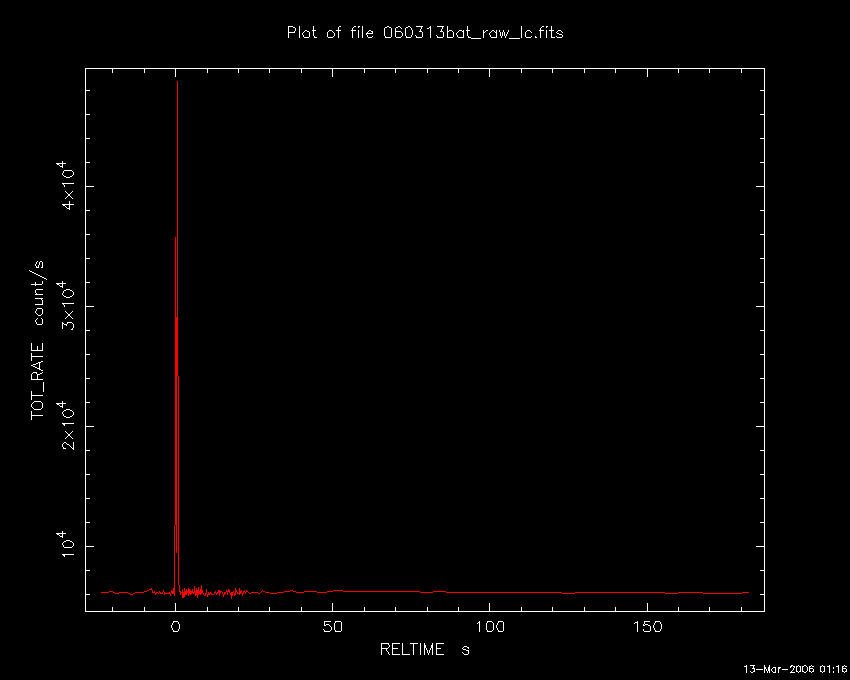
- GCN NOTICE
TITLE: GCN/SWIFT NOTICE
NOTICE_DATE: Mon 13 Mar 06 00:17:12 UT
NOTICE_TYPE: Swift-UVOT Source List
TRIGGER_NUM: 201487, Seg_Num: 0
POINT_RA: 66.599d {+04h 26m 24s} (J2000)
POINT_DEC: -10.865d {-10d 51' 54"} (J2000)
POINT_ROLL: 270.007d
IMG_START_DATE: 13807 TJD; 72 DOY; 06/03/13
IMG_START_TIME: 803.74 SOD {00:13:23.74} UT, 77.5 [sec] since BAT Trigger Time
FILTER: 3, V
BKG_MEAN: 0.765
N_STARS: 17
X_OFFSET: 370 [pixels]
Y_OFFSET: 540 [pixels]
X_MAX: 1329 [pixels]
Y_MAX: 1499 [pixels]
DET_THRESH: 8
PHOTO_THRESH: 3
SL_URL: sw00201487000msufc0077.fits
SUN_POSTN: 352.91d {+23h 31m 39s} -3.06d {-03d 03' 42"}
SUN_DIST: 73.48 [deg] Sun_angle= -4.9 [hr] (East of Sun)
MOON_POSTN: 153.98d {+10h 15m 55s} +13.90d {+13d 54' 15"}
MOON_DIST: 90.02 [deg]
MOON_ILLUM: 97 [%]
GAL_COORDS: 205.94,-37.08 [deg] galactic lon,lat of the pointing direction
ECL_COORDS: 62.58,-32.10 [deg] ecliptic lon,lat of the pointing direction
COMMENTS: SWIFT-UVOT Source List.
- GCN NOTICE
TITLE: GCN/SWIFT NOTICE
NOTICE_DATE: Mon 13 Mar 06 00:18:03 UT
NOTICE_TYPE: Swift-UVOT Processed Source List
TRIGGER_NUM: 201487, Seg_Num: 0
POINT_RA: 66.599d {+04h 26m 24s} (J2000)
POINT_DEC: -10.865d {-10d 51' 54"} (J2000)
POINT_ROLL: 270.007d
IMG_START_DATE: 13807 TJD; 72 DOY; 06/03/13
IMG_START_TIME: 803.74 SOD {00:13:23.74} UT, 77.5 [sec] since BAT Trigger Time
FILTER: 3, V
BKG_MEAN: 0.765
N_STARS: 17
X_OFFSET: 370 [pixels]
Y_OFFSET: 540 [pixels]
X_MAX: 1329 [pixels]
Y_MAX: 1499 [pixels]
DET_THRESH: 8
PHOTO_THRESH: 3
SL_URL: sw00201487000msufc0077.fits
SUN_POSTN: 352.91d {+23h 31m 39s} -3.06d {-03d 03' 42"}
SUN_DIST: 73.48 [deg] Sun_angle= -4.9 [hr] (East of Sun)
MOON_POSTN: 153.98d {+10h 15m 56s} +13.90d {+13d 54' 04"}
MOON_DIST: 90.03 [deg]
MOON_ILLUM: 97 [%]
GAL_COORDS: 205.94,-37.08 [deg] galactic lon,lat of the pointing direction
ECL_COORDS: 62.58,-32.10 [deg] ecliptic lon,lat of the pointing direction
COMMENTS: SWIFT-UVOT Processed Source List.
COMMENTS: All 4 attachments are included.
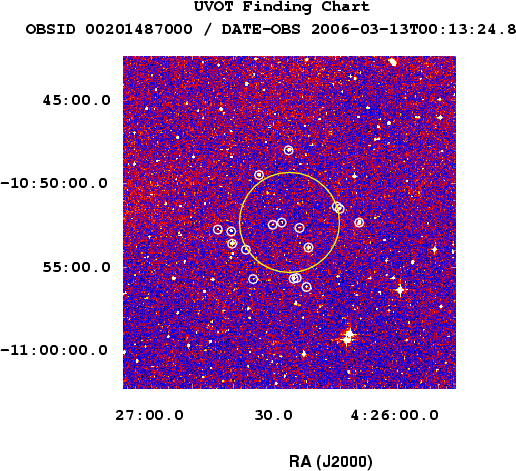
- GCN NOTICE
TITLE: GCN/SWIFT NOTICE
NOTICE_DATE: Mon 13 Mar 06 00:18:32 UT
NOTICE_TYPE: Swift-UVOT Image
TRIGGER_NUM: 201487, Seg_Num: 0
POINT_RA: 66.599d {+04h 26m 24s} (J2000)
POINT_DEC: -10.865d {-10d 51' 54"} (J2000)
ROLL: 270.007d
IMG_START_DATE: 13807 TJD; 72 DOY; 06/03/13
IMG_START_TIME: 803.74 SOD {00:13:23.74} UT, 77.5 [sec] since BAT Trigger Time
FILTER: 3, V
EXPOSURE_ID: 163901604
X_OFFSET: 690 [pixels]
Y_OFFSET: 860 [pixels]
WIDTH: 160 [pixels]
HEIGHT: 160 [pixels]
X_GRB_POS: 850
Y_GRB_POS: 1020
BINNING_INDEX: 1
IM_URL: sw00201487000msuni0077.fits
SUN_POSTN: 352.91d {+23h 31m 39s} -3.06d {-03d 03' 41"}
SUN_DIST: 73.48 [deg] Sun_angle= -4.9 [hr] (East of Sun)
MOON_POSTN: 153.99d {+10h 15m 57s} +13.90d {+13d 53' 58"}
MOON_DIST: 90.03 [deg]
MOON_ILLUM: 97 [%]
GAL_COORDS: 205.94,-37.08 [deg] galactic lon,lat of the pointing direction
ECL_COORDS: 62.58,-32.10 [deg] ecliptic lon,lat of the pointing direction
COMMENTS: SWIFT-UVOT Image.
COMMENTS: The GRB Position came from the Window Position in the Mode Command.
COMMENTS: The image has 2x2 binning (compression).
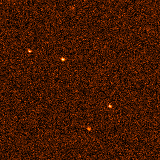
- GCN NOTICE
TITLE: GCN/SWIFT NOTICE
NOTICE_DATE: Mon 13 Mar 06 00:19:45 UT
NOTICE_TYPE: Swift-UVOT Processed Image
TRIGGER_NUM: 201487, Seg_Num: 0
POINT_RA: 66.599d {+04h 26m 24s} (J2000)
POINT_DEC: -10.865d {-10d 51' 54"} (J2000)
ROLL: 270.007d
IMG_START_DATE: 13807 TJD; 72 DOY; 06/03/13
IMG_START_TIME: 803.74 SOD {00:13:23.74} UT, 77.5 [sec] since BAT Trigger Time
FILTER: 3, V
EXPOSURE_ID: 163901604
X_OFFSET: 690 [pixels]
Y_OFFSET: 860 [pixels]
WIDTH: 160 [pixels]
HEIGHT: 160 [pixels]
X_GRB_POS: 850
Y_GRB_POS: 1020
BINNING_INDEX: 1
IM_URL: sw00201487000msuni0077.fits
SUN_POSTN: 352.91d {+23h 31m 39s} -3.06d {-03d 03' 40"}
SUN_DIST: 73.48 [deg] Sun_angle= -4.9 [hr] (East of Sun)
MOON_POSTN: 154.00d {+10h 15m 59s} +13.90d {+13d 53' 43"}
MOON_DIST: 90.04 [deg]
MOON_ILLUM: 97 [%]
GAL_COORDS: 205.94,-37.08 [deg] galactic lon,lat of the pointing direction
ECL_COORDS: 62.58,-32.10 [deg] ecliptic lon,lat of the pointing direction
COMMENTS: SWIFT-UVOT Processed Image.
COMMENTS: The GRB Position came from the Window Position in the Mode Command.
COMMENTS: The image has 2x2 binning (compression).
COMMENTS: All 4 attachments are included.
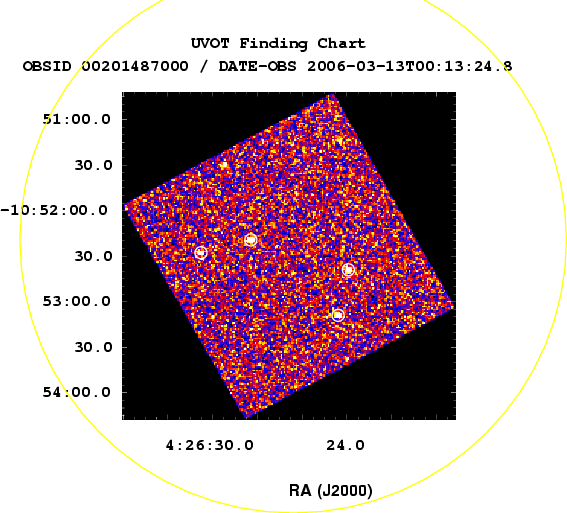
- GCN Circular #4867
C. Pagani (PSU), S. Barthelmy (GSFC), J. Cummings (GSFC/ORAU), N. Gehrels (GSFC),
D. Grupe (PSU), S.T. Holland (GSFC/USRA), S. Hunsberger (PSU),
C. Markwardt (GSFC/UMD), F. Marshall (GSFC), D. Palmer (LANL)
on behalf of the Swift team:
At 00:12:06 UT, Swift-BAT triggered and located GRB 060313 (trigger=201487).
The spacecraft slewed immediately. The BAT on-board calculated location is
RA,Dec 66.609d,-10.872d {04h 26m 26s,-10d 52' 19"} (J2000), with an uncertainty
of 3 arcmin (radius, 90% containment, stat+sys). The BAT light curve shows
two slightly overlapping peaks with a total duration of ~1.6 sec.
The first peak start at ~T-0.7 sec and the second peak ends by T+0.9 sec.
The peak count rate was ~40,000 counts/sec (15-350 keV), at ~0.0 seconds
after the trigger. This is definitely a short hard burst.
The XRT began taking data at 00:13:24 UT, 79 seconds after the BAT trigger.
The XRT on-board centroid algorithm did not find a source in the image and
no prompt position is available. We are waiting for down-linked data
to detect and determine a position for the source.
UVOT took a finding chart exposure of 200 seconds with the V filter starting
78 seconds after the BAT trigger. No afterglow candidate has been found
in the initial data products. The 2.7'x2.7' sub-image covers 25% of the
BAT error circle. The typical 3-sigma upper limit has been about 18th mag.
The 8'x8' region for the list of sources generated on-board covers 100%
of the BAT error circle. The list of sources is typically complete to
about 18.0 mag. No correction has been made for the expected extinction
of about 0.2 magnitudes.
We note that the magnitude B=16.3 galaxy LEDA 3093309 (aka NPM1G -10.0175)
is within 5 arcminutes of the BAT position, however there is currently
no evidence for a physical association between these two objects.
- GCN Circular #4868
A. Melandri, S. Covino, E. Molinari, G. Chincarini, F.M. Zerbi,
V. Testa, G. Tosti, F. Vitali, L.A. Antonelli, P. Conconi, G. Cutispoto,
G. Malaspina, L. Nicastro, E. Palazzi, E. Meurs, P. Goldoni,
on behalf of the REM/ROSS Team
We imaged the field of the short hard burst GRB 030613 (GCN 4867,
Pagani et al.) with the robotic 60-cm REM telescope located at
La Silla, Chile.
The observations were performed both with the optical and the
infrared camera of the REM telescope and started about 33 seconds
after the GCN alert and about 45 seconds after the burst.
First inspection of visual and infrared images do not reveal any new
source inside the Swift-BAT error circle (GCN 4867, Pagani et al.)
down to the limiting magnitude of the 2MASS catalog.
Further observations and analises are still ongoing.
This message is citeable.
- GCN Circular #4869
B. E. Cobb, part of the larger SMARTS consortium, reports:
Using the ANDICAM instrument on the 1.3m telescope at CTIO, we
obtained optical/IR imaging of the error region of GRB 060313
(Pagani et al. GCN 4867) beginning ~0.3 hours post-burst
(2006-03-13 00:31 UT). Optical imaging in B,V,R and I has a
field of view of 6'x6' and, therefore, covers the entire GRB
error circle. IR imaging in J, H, K and Y has a smaller field
of view (2.4'x2.4') and covers a region totaling 5.8 square arcminutes in
the middle of the quoted error region. Several dithered images
were obtained in each filter, with total summed exposure times
of 180s in each of BRIYJK and 120s in each of H and V.
Preliminary visual comparison of the optical images to the DSS
and the IR images to 2MASS frames does not reveal any new sources.
The detection limits of the combine ANDICAM images are slightly
shallower than that of MASS and the DSS.
- GCN Circular #4870
C. Pagani (PSU), D. Burrows (PSU) report on behalf of the Swift XRT
team:
We have analyzed the Swift XRT data from the first orbit of observation of GRB
060313 (Pagani et al., GCN 4867). We find an uncatalogued source at the
following location:
RA(J2000) = 04h 26m 28.4s
Dec(J2000) = -10d 50m 41.5s
We estimate an uncertainty of 8 arcseconds radius (90% containment).
This position is 103 arcseconds from the BAT position given in GCN 4867. A full
analysis of the XRT data will follow.
This circular is an official product of the Swift XRT Team.
- GCN Circular #4871
A.J. Levan (U. Hertfordshire), J. Hjorth (Dark Cosmology Centre) report
for the GRACE collaboration:
We observed the location of the short hard GRB 060313 (Pagani et al.
GCN 4867) with the VLT and FORS2 beginning at 01:28 UT. At the location
of the X-ray afterglow reported by Pagani et al. (GCN 4870) we find a
point source which is not visible in the DSSII (red) although is somewhat
brighter than its limiting magnitude. We suggest this is the afterglow of
GRB 060313.
The location of the source is:
RA = 04:26:28.4
Dec = -10:50:40.1
Currrently we estimate our uncertainty in this position is ~0.5" in each axis.
Further observations are planned.
- GCN Circular #4872
B. E. Cobb, part of the larger SMARTS consortium, reports:
Following the report of a possible X-ray afterglow to GRB 060313,
the SMARTS imaging described in GCN 4869 was re-examined.
The X-ray position is unfortunately outside our NIR imaging. In our
R and I band images, however, there is a possible optical counterpart
within the X-ray detection error region, at preliminary coordinates of:
RA = 4:26:28.45
Dec = -10:50:39.9
The source is only detected at the 1 sigma level, but the fact
that it is visible in both R and I suggests the source is not
spurious. The source is not detected in the DSS images.
In comparison with several nearby USNO-B1.0 stars, the
source has a magnitude of R ~ 19.9 +/- 0.3.
- GCN Circular #4873
C. Markwardt (GSFC/UMD), L. Barbier (GSFC), S. Barthelmy (GSFC),
J. Cummings (GSFC/NRC), E. Fenimore (LANL), N. Gehrels (GSFC),
D. Hullinger (BYU-Idaho), H. Krimm (GSFC/USRA), D. Palmer (LANL),
A. Parsons (GSFC), T. Sakamoto (GSFC/NRC), G. Sato (ISAS),
J. Tueller (GSFC)
on behalf of the Swift-BAT team:
Using the data set from T-60 to T+123 sec from the recent telemetry downlink,
we report further analysis of BAT GRB 060313 (trigger #201487)
(Pagani, et al., GCN 4867). The BAT ground-calculated position is RA,Dec =
66.624,-10.859 deg {04h 26m 29.8s,-10d 51' 30.9"} (J2000) +- 1.0 arcmin,
(radius, sys+stat, 90% containment). The partial coding was 54%.
The lightcurve shows 3 or 4 overlapping peaks. They start with a very fast
rise (less than 40 msec). There is a possibility of further faint emission
past the end of the last peak (T+1 to T+2 sec). T90 (15-350 keV) is
0.7 +- 0.1 sec (estimated error including systematics).
The time-averaged spectrum from T+0.06 to T+0.94 is best fit by a simple
power-law model. The power law index of the time-averaged spectrum
is 0.71 +- 0.07. The fluence in the 15-150 keV band is
1.13 +- 0.05 x 10^-6 erg/cm2. The 1-sec peak photon flux measured
from T+0.01 sec in the 15-150 keV band is 12.1 +- 0.4 ph/cm2/sec.
All the quoted errors are at the 90% confidence level.
- GCN Circular #4874
Christina Thoene, Chloe Feron, Jens Hjorth and Brian L. Jensen (Dark
Cosmology Centre) report
We obtained R and I band observations of GRB 060313 (GCN 4867) with the
Danish 1.5m telescope and DFOSC at La Silla. Observations started at UT
00:23:53 (11min after the burst) until UT 02:11:10. Inside the XRT error
circle (GCN 4870) we detect a new, previously uncatalogued source at the
position (J2000)
RA = : 04:26:28.42
Dec =-10:50:39.84
This is consistent with the position reported in GCN 4871 and GCN 4872.
The R magnitude obtained from stacked images with a mean time of about 1h
after the burst is
R = 20.4 (based on preliminary photometric zero points)
A finding chart can be found at:
http://www.astro.ku.dk/~brian_j/grb/grb060313.008/
- GCN Circular #4875
C. Pagani (PSU), D. Morris (PSU), D. Grupe (PSU) and D. Burrows (PSU) report on
behalf of the Swift XRT team:
We have analyzed the first two orbits of Swift XRT data of GRB 060313 (Pagani et
al., GCN 4867). The revised XRT position is
RA(J2000) = 04h 26m 28.5s
Dec(J2000) = -10d 50m 40.2s
We estimate an uncertainty of 4 arcseconds radius (90% containment).
The revised position is 2 acrseconds from the suggested optical afterglow
reported by Levan et al. (GCN 4871) and 1.5 arcseconds form the previously
reported XRT position (GCN 4870).
The X-ray spectrum of the data can be fitted by a single absorbed power law with
a photon index Gamma=1.70+/-0.10 and an absorption column density nH consistent
with the Galactic value of 4.7e20cm-2; Dickey & Lockman 1990.
The light curve shows a decay during with alpha=1.50+/-0.18. Assuming this decay
slope the prediction for the flux 24 hours after the trigger is 1.2e-13
ergs/s/cm2.
This circular is an official product of the Swift XRT Team.
- GCN Circular #4876
B. Schmidt (ANU), Derek Fox (Penn State), and Edo Berger (OCIW), on
behalf of a larger collaboration report,
"We have obtained a series of r-band images with Gemini-S + GMOS between
UT Mar 13.058 and March 13.096 of GRB 060313 (Pagani et al. GCN 4867) of
the OT-candidate of Levan and Hjorth (GCN 4871). Comparison with USNOA2
star located at
RA=04:26:28.906 DEC=-10:51:00.16 (J2000) R=18.1
shows the OT-candidate to be 2.19 magnitudes fainter than the star at
Mar 13.058, and 2.26 mags fainter at Mar 13.096, a marginally
significant difference. It is possible that an underlying host galaxy is
significantly affecting the photometry.
We would like to thank the Gemini Staff for their help in executing
these Target of Opportunity observations."
- GCN Circular #4877
P. Schady (PSU/MSSL-UCL) C. Pagani (PSU) on behalf of the Swift/UVOT team
The Swift/UVOT began taking data on the field of GRB 060313 at 00:13:23 UT on
2006-03-13, approximately 79s after the BAT trigger (Pagani et al., GCN 4867).
The afterglow is detected above the 2-sigma level in the V, B and UVW2 filter
at a position consistent with that reported by Cobb et al. (GCN 4872), and
there is a tenuous detection in the U and UVW1 band coadded exposures at the
1.4 and 1.2 sigma level, respectively. The detection in UVW2 implies that
the Lyman limit must be blueward of ~2500 A, providing a redshift upper
limit of z <~1.7.
All detections above 2-sigma and the 2-sigma upper limits from the coadded
image of a set of exposure for each filter are as follows:
Filter T_range(s) Exp(s) Average mag/UL sigma
V 177-6963 933 20.03+/-0.39 2.9
B 469-5453 953 20.69+/-0.48 2.7
U 415-844 100 > 19.95
UVW1 361-790 100 > 18.91
UVM2 307-736 100 > 18.89
UVW2 578-900 950 20.98+/-0.5 2.2
These magnitudes are uncorrected for Galactic extinction;
E(B-V) = 0.067.
- GCN Circular #4878
M. Nysewander, J. Haislip, D. Reichart, K. Ivarsen, A. LaCluyze, J. A.
Crain, A. Foster, J. Kirschbrown, C. MacLeod, and A. Trotter report on
behalf of the UNC team of the FUN GRB Collaboration:
Skynet observed the localization of GRB 060313 (Pagani et al., GCN 4867)
with two of the 16-inch PROMPT telescopes at CTIO beginning 43.7 min after
the burst in r'i'I.
A preliminary analysis of the data shows the candidate afterglow first
reported by Levan & Hjorth (GCN 4871) to be at r' = 19.9 +- 0.3 and I =
19.7 +- 0.3 at mean times of 1.3 hours and 1.4 hours after the burst.
PROMPT also made a marginal detection (~2 sigma) of i' ~ 20.5 at a mean
time of 1.5 hours after the burst. We used five calibration stars that
were taken from the USNO-B1.0 and NOMAD catalogues and transformed to the
SDSS filters via Smith et al. 2002.
PROMPT is currently being built and commissioned.
- GCN Circular #4879
S. Barthelmy (GSFC), J. Cummings (GSFC/NRC), N. Gehrels (GSFC),
H. Krimm (GSFC/USRA), J. Norris (GSFC), T. Sakamoto (GSFC/NRC),
D. Palmer (LANL
on behalf of the Swift-BAT team:
Using the data set from T-300 to T+300 sec from additional telemetry
downlinks, we report further analysis of BAT GRB 060313 (trigger #201487)
(Pagani, et al., GCN 4867; Markwardt, et al., 4873). This short burst
does not show any sign of extended emission in the T+1 to T+300 sec range
at an upper limit of 0.001 cnt/detector/sec. This corresponds to a
flux ratio upper limit between the initial peak and the peak of any
potential extended emission of 2000. We reference SHBs 050724 and 051227
which had ratios of 46 and ~10, respectively.
The lag analysis shows this burst to be cleanly in the short hard burst class
(Norris and Bonnell, 2006, ApJ, accepted; see, Figure 3).
Specifically, the measured lags are:
50-100 keV to 15-25 keV: 0.8 ms +- 0.6 ms
100-350 keV to 25-50 keV: 0.3 ms +- 0.7 ms
We further note that the lightcurve has multiple structures. There are
at least 20 statistically significant peaks with FWHM in the 5-15 msec range.
There is no perdiodic structure in the lightcurve for at least
the first 100 sec.
- GCN Circular #4880
B. Schmidt and D. Bayliss (ANU), on behalf of a larger collaboration
report,
"We have obtained a series of R-band images with 40inch telescope + WFI
starting at UT Mar 13.358 of GRB 060313 (Pagani et al. GCN 4867) of the
OT-candidate of Levan and Hjorth (GCN 4871).
Comparison of the image with those taken with Gemini-S (Schmidt et al.
GCN 4876)
shows the OT-candidate has faded by at least 0.4 magnitudes (95%
confidence).
Although not detected, using the USNOA2 star located at
RA=04:26:28.906 DEC=-10:51:00.16 (J2000) R=18.1
as a reference, we estimate the OT to be fainter than R=20.5 (95%
confidence). This variability confirms the association of the OT with
GRB060313."
- GCN Circular #4881
S. Golenetskii, R.Aptekar, E. Mazets, V. Pal'shin, D. Frederiks, and
T. Cline on behalf of the Konus-Wind team report:
The GRB 060313 (Swift-BAT trigger #201487;
Pagani et al., GCN 4867; Markwardt et al., GCN 4873)
triggered Konus-Wind at T0=726.354 s UT (00:12:06.354).
The Konus-Wind light shows several multipeaked
pulses with a total duration of ~0.8 sec.
As observed by Konus-Wind the burst had
a fluence of 1.42(-0.85, +0.10)x10^-5 erg/cm2 and
peak flux on 16-ms time scale measured from T-T0=0.560 sec
7.0(-4.3, +1.0)x10^-5 erg/cm2/sec
(both in the 20 keV - 2 MeV energy range).
The time-integrated spectrum of the GRB
is well fitted (in the 20 keV - 2 MeV range)
by a power law with exponential cutoff model:
dN/dE ~ E^(-alpha) * exp(-(2-alpha)*E/Ep)
with alpha = 0.60(-0.22, +0.19)
and Ep = 922(-177, +306) keV (chi2 = 62/59 dof).
The fitting of the spectrum of the GRB initial part
(accumulated from T-T0=0 to T-T0=0.192 sec in
the same energy range)
gives an unusual photon index alpha:
alpha = -0.33(-0.29, +0.25)
Ep = 655(-74, +84)
(chi2 = 51/59 dof).
All the quoted errors are at the 90% confidence level.
The Konus-Wind light curve of this GRB is available
at http://www.ioffe.rssi.ru/LEA/GRBs/GRB060313_T00726/
- GCN Circular #4883
A. Melandri, S. Covino, E. Palazzi, L.A. Antonelli, E. Molinari,
G. Chincarini, F.M. Zerbi,, V. Testa, G. Tosti, F. Vitali, P. Conconi,
G. Cutispoto, G. Malaspina, L. Nicastro, E. Meurs, P. Goldoni,
on behalf of the REM/ROSS Team
The field of the short hard burst GRB 030613 (GCN 4867, Pagani et al.)
was imaged by the robotic 60-cm REM telescope with the both infrared
(REMIR) and optical (ROSS) camera.
Observations started about 33 seconds after the GCN alert about 45
seconds after the burst and a total exposure time of 325, 425 and 325
seconds was obtained with J, H and Ks filter respectively. Preliminary
results on these data have been reported in GCN 4868 (Melandri et al.).
A refined analysis have been performed on the IR stacked images and
no new source is found within the XRT refined error circle (Pagani et
al., GCN 4875) and at the position of the OT-candidate suggested by
Levan and Hjorth (GCN 4871).
We derive the following upper limits for the NIR afterglow:
Filter Delta_T (days) Mag_Lim (5 sigma)
J 0.018 17.6
H 0.012 17.2
Ks 0.010 16.5
Optical images, acquired with the ROSS optical camera in the I, R and
V filters, do not allow to obtain useful information because of a large
contamination due to the Moon light. We were able to derive an upper
limit only of R > 17.5.
This message is citeable.
- GCN Circular #4884
A. M. Soderberg (Caltech) and D. A. Frail (NRAO) report on
behalf of a large collaboration:
"We observed the field of GRB 060313 with the Very Large Array
on 2006 March 15.13 UT. No radio source is detected at the
position of the optical afterglow (GCN 4871). We place
an upper limit of 0.11 mJy (3-sigma) at 8.46 GHz."
- astro-ph/0605005 from 28 Apr 2006
Roming: GRB 060313: A New Paradigm for Short-Hard Bursts?
We report the simultaneous observations of the prompt emission in the
gamma-ray and hard X-ray bands by the Swift-BAT and the KONUS-Wind instruments
of the short-hard burst, GRB 060313. The observations reveal multiple peaks in
both the gamma-ray and hard X-ray suggesting a highly variable outflow from the
central explosion. We also describe the early-time observations of the X-ray
and UV/Optical afterglows by the Swift XRT and UVOT instruments. The
combination of the X-ray and UV/Optical observations provide the most
comprehensive lightcurves to date of a short-hard burst at such an early epoch.
The afterglows exhibit complex structure with different decay indices and
flaring. This behavior can be explained by the combination of a structured jet,
radiative loss of energy, and decreasing microphysics parameters occurring in a
circum-burst medium with densities varying by a factor of approximately two on
a length scale of 10^17 cm. These density variations are normally associated
with the environment of a massive star and inhomogeneities in its windy medium.
However, the mean density of the observed medium (n ~ 10^-3 cm^3) is much less
than that expected for a massive star. Although the collapse of a massive star
as the origin of GRB 060313 is unlikely, the merger of a compact binary also
poses problems for explaining the behavior of this burst. Two possible
suggestions for explaining this scenario are: some short bursts may arise from
a mechanism that does not invoke the conventional compact binary model, or soft
late-time central engine activity is producing UV/optical but no X-ray flaring.
- the above paper astro-ph/0605005
also list an imporved redshift limit of <1.1
![]() Previous IAU Circulars
Previous IAU Circulars 



